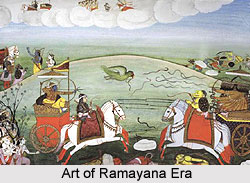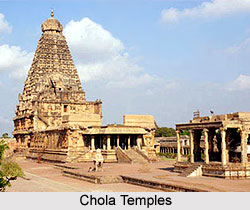 The history of art in ancient India commence with prehistoric rock paintings as can be seen in the Bhimbetaka paintings, which belongs to the prehistoric age. Thereafter art in India was produced in the great cities of the Indus valley civilisation during 2000B.C. It was followed by the Epic period (1500-600B.C) which witnessed the invasion of the Aryans and a merging of Aryan and Dravidian art. The Vedic age gave way to the Maurya period which introduced the use of stone in architecture and this era was marked by the influence of Buddhism which continued till the Kushan period.
The history of art in ancient India commence with prehistoric rock paintings as can be seen in the Bhimbetaka paintings, which belongs to the prehistoric age. Thereafter art in India was produced in the great cities of the Indus valley civilisation during 2000B.C. It was followed by the Epic period (1500-600B.C) which witnessed the invasion of the Aryans and a merging of Aryan and Dravidian art. The Vedic age gave way to the Maurya period which introduced the use of stone in architecture and this era was marked by the influence of Buddhism which continued till the Kushan period.
The art of Indus valley was mainly based on city architecture that is the town planning. It was devoid of any decorative architecture but was of a startling utilitarian character. The remains of the great bath and the granary are examples of the remarkable architecture that flourished during the Indus valley civilisation. Apart from building architecture there are some outstanding sculptures like the figurine of a dancing girl, a male bust, potteries etc that have been excavated from this site. People in this age experimented with different materials like terracotta, limestone, bronze and copper . The unearthed effigies of mother goddess explicate the belief of the Indus valley people in nature.
The Indus valley civilisation was followed by the Vedic period that came into being after the Aryans invaded India. Their building materials were those most readily available for construct¬ing shelters: wood, bamboo, thatch, and, prob¬ably only later, brick. The architecture of the Vedic period was neither monumental nor concentrated in urban developments. Fire alters and sacrificial halls are mentioned in the Vedas. This period was also known as the epic period and reference of shrine and assembly are found in the Ramayana and the Mahabharata. The materials used are mainly brick and wood and sometimes stones.
The Vedic period paved way for the Maurya period which reached the zenith of its artistic development during the middle years of third century B.C. there was a huge impact of Buddhist religion in this period. The ruins of the fabulous city of Pataliputra speak volumes about the extraordinary craftsmanship and permanence of the city`s girdle of fortifications. This period witnessed the emergence of the technique of stone-carving. Buddhist stupas like those at Sanchi and Sarnath and probably Amravati were originally built as brick and masonry mounds during the reign of emperor Ashoka . Sunga period followed the Maurya period and the main sculpture of Sunga period comprise of the decoration of the stone railings and gateways that now surround the Buddhist Stupa or relic mound.
Art under the Kushanas flourished to a great extent with the emergence of Gandhara School and Mathura school of art. A headless statue of Kanishka reveals the practice of making effigies of kings and emperors during the Kushana period. There was a development of Greco- Buddhism, which was a fusion of Hellenistic and Buddhists cultural elements and the sculptors of Mathura undoubtedly deserve credit for creating the earliest, entirely Indian representations of the Buddha. Sculpture in relief under the Kushanas at Mathura is in many respects an outgrowth of the styles of the archaic period, although at the same time it is undoubtedly influenced by innovations from Gandhara, most notably in the inclusion of Buddha in anthropomorphic form.
The Gupta period witnessed an amalgamation of Hindu and Buddhist influence. In this period the chaitya-hall makes its appearance as a free-standing temple of permanent materials. The facade of the building presents the characteristic chaitya-arch form of the rock-cut chaitya-halls which at one time probably framed a Buddhist subject in relief.
Among the characteristics of Gupta temple architecture is the flat roof with spouts to drain off rain-water. In the Gupta art, a combination of an entirely new and fresh concept with elements of tradition is perceived. The temple of Vishnu at Deogarh is one of the Hindu architecture of Gupta period. Cave paintings during the Gupta period gained immense impetus which is evident in the paintings of Ajanta. Mahayana sculpture, as exemplified by the carvings of the Great Stupa at Barabudur, marks a final crystallization of the Gupta ideal.
 By the seventh century A.D. Buddhism had largely disappeared from the northern India and in down south there was the rise of Hinduism. In south the Pallava sculpture, descended, no doubt, from that at Buddhist Amaravat I, is notable for its restrained elegance. Main sculptures were a number of mytho¬logical relief carvings in caves and on rock-faces and the group of such carv¬ings at Mamallapuram is one of the chief beauties of Indian art. Under the enormously powerful Chola Dynasty, the eastern coast of the peninsula became the place of yet another pinnacle of art. The early Chola temples dedicated to Lord Shiva were pyramidal shrine and the tower was nearly 200 feet high and crowned by an eighty-ton ornate dome-capstone. The Cholas are more artistically remarkable for the extraordinary school of bronze sculpture. Statues of Hindu deities were produced ranging from almost life-size to a few inches high. There were many images of Hindu saints in adoration; but perhaps the best-known type is that which represents Lord Shiva as the beautiful "Lord of the Dance", posing with one knee cocked out, in an aureole of flame.
By the seventh century A.D. Buddhism had largely disappeared from the northern India and in down south there was the rise of Hinduism. In south the Pallava sculpture, descended, no doubt, from that at Buddhist Amaravat I, is notable for its restrained elegance. Main sculptures were a number of mytho¬logical relief carvings in caves and on rock-faces and the group of such carv¬ings at Mamallapuram is one of the chief beauties of Indian art. Under the enormously powerful Chola Dynasty, the eastern coast of the peninsula became the place of yet another pinnacle of art. The early Chola temples dedicated to Lord Shiva were pyramidal shrine and the tower was nearly 200 feet high and crowned by an eighty-ton ornate dome-capstone. The Cholas are more artistically remarkable for the extraordinary school of bronze sculpture. Statues of Hindu deities were produced ranging from almost life-size to a few inches high. There were many images of Hindu saints in adoration; but perhaps the best-known type is that which represents Lord Shiva as the beautiful "Lord of the Dance", posing with one knee cocked out, in an aureole of flame.
Art in ancient India can be traced from the city architecture of the Indus valley civilisation, followed by the epic period and then the Sunga, Kushana, Maurya and the Gupta period in the northern India and by the Chola, Chera and Pallava Empire in the south. Religion like Hinduism and Buddhism has also affected art in ancient India at different era which finds expression in the architecture and sculpture of the respective period.




